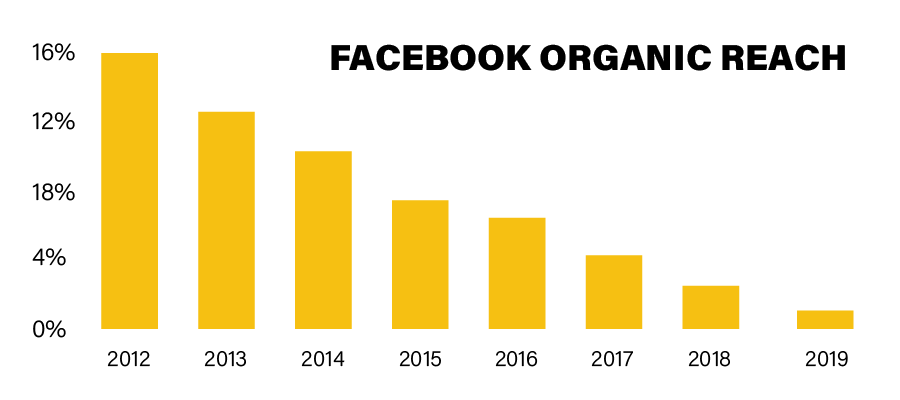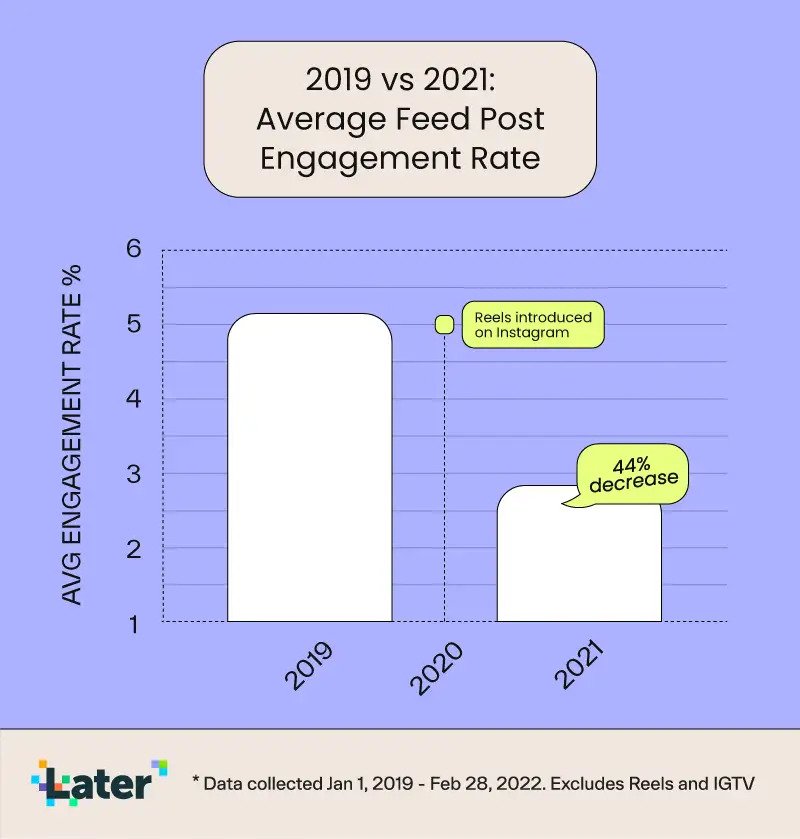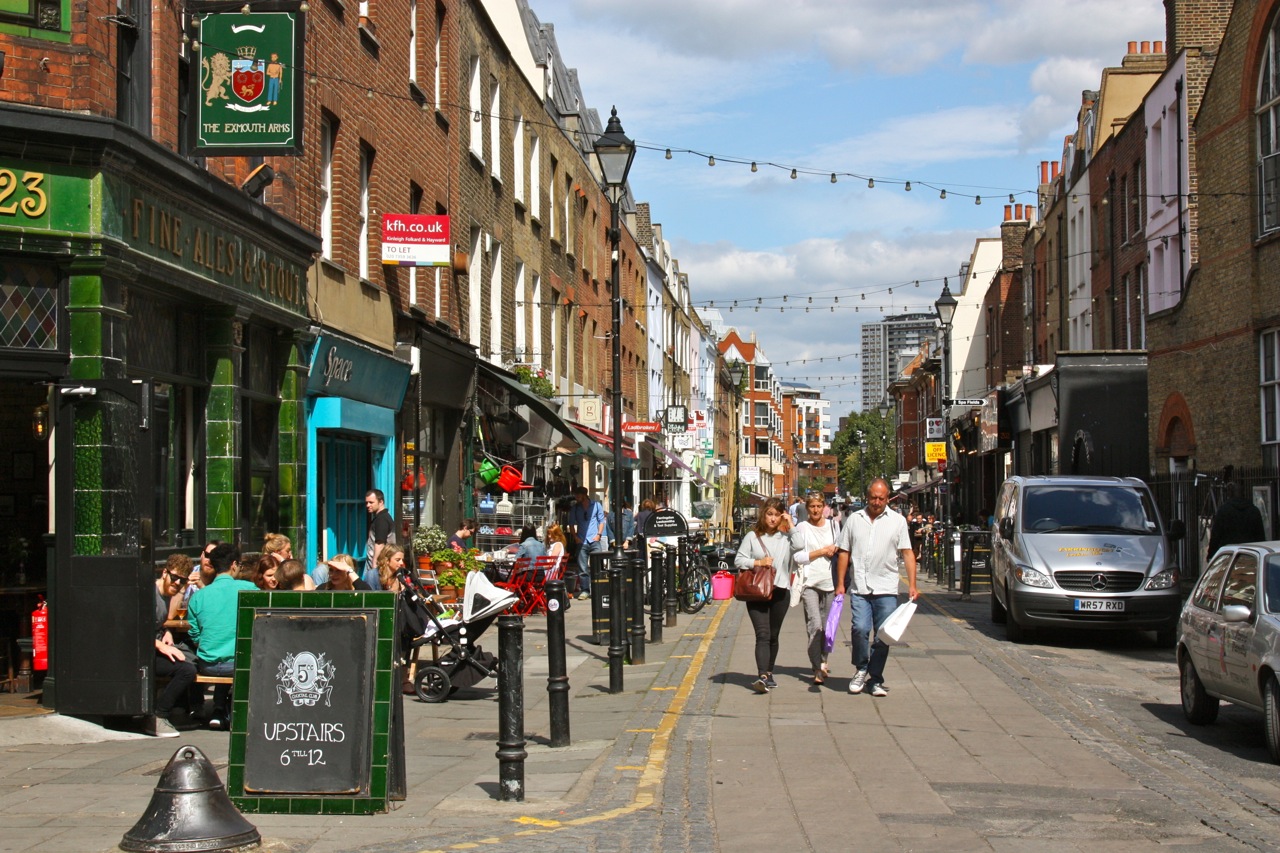How many local businesses can you name that advertise on Facebook, Twitter, TikTok or Instagram?
By advertise, I don’t mean post on their own accounts or in Facebook Groups, I mean businesses who actually pay money for promoted tweets, Facebook advertising, TikTok ads or boosted Instagram posts?
I’m guessing it’s not very many and, if so, that’s a big issue. Why? Well, Well just take a look at this graph.

If you talk to businesses owners, most appear to be stuck in the good ol’ days (pre-2012) when you could throw up a post on Facebook and reach 16% of followers through your newsfeed. Today reach can easily be as low as 2%. If it feels like you are shouting into the void sometimes, you probably are.

Instagram is on the same path. Short-form video is now Instagram’s top priority and this has heavily impacted engagement rates of posts. Static text and picture post engagement has dropped by 44% since 2021. So to keep the same level of engagement, businesses who regularly post to Instagram accounts now also need to create, edit and post videos? As you know, time pressures, know-how and basic inertia around what to post makes this highly unlikely.
The truth is organic reach is dying across all social media platforms, but most local business owners have no clue about this whatsoever.
If social media is the main channel that local businesses use to promote their services, products and events … then local engagement in your town will have fallen significantly over the past 5-10 years. This is bad for business, social cohesion and town health in general.
Why is this happening and, more importantly, what impact is this having on local businesses?
Let’s start by considering the priorities of the social media platforms. In 2022, Meta’s revenues were nearly $117bn with $23.1bn net profit. Even then Mr Zuckerberg faced questions as the markets weren’t happy. Twitter, now led by Elon Musk, has $1.5bn of debt to service and is struggling to break even despite earning $4.4bn in revenue. Both are threatened by TikTok which amassed $9.4bn of revenue globally in 2022.

Musk, Zuckerberg and Shou Zi Chew (TikTok) are all battling to win the biggest slice of the $multi-billion advertising pie. Multinational giants like Samsung and Proctor & Gamble spend hundreds of millions of dollars trying to reach consumers on social media.
To ordinary folk, these are staggering sums of money. Where do small local businesses fit in? Is the well-being of your town or community anywhere near the top of these tech behemoths agendas? If you add antitrust lawsuits, billion dollar ‘next big thing in tech’ investments, waves of employee layoffs and restructuring in to the mix, the answer is clearly ‘no.’
Indeed, why should it be? Tech companies are not in the business of maintaining the status quo, they are disruptive by nature. ‘Societal change’ (aka collateral damage) is par for the course when it comes to the onward march of technology, whether intentional or not. The fundamental business drivers for these corporations are user adoption, revenue growth and profit. Consequently, their algorithms are calibrated to ensure as many businesses as possible advertise, whilst ensuring there’s just enough value to warrant a level of organic posting.
My favourite pub often shares a pic of its Sunday Roast on the local Facebook Group. Sure, the pub will benefit from the views of its post – and it may sell one or two additional covers if it’s lucky – but because the posts aren’t being paid-for, Facebook doesn’t maximise the pub’s earning potential with the data or targeting tools the platform has available.
In effect, local businesses are marketing online sub-optimally by design. In better times, this wasn’t an issue because a few extra sales meant a bit of extra profit. Now ‘a few extra sales’ means a lot more when they are struggling to break even.
What if, when the the pub had posted, instead of 1 in 19 of their followers seeing the post, 19 out of 19 had seen it? What if they could be sure their posts had been seen by the same people multiple times? What if their post had been seen by people who enjoy dining out? Well, for one thing they would sell far more covers on a Sunday.

The social media platforms would say that’s absolutely possible, you just need to pay us – just advertise like Samsung and Proctor & Gamble! The trouble is most local businesses are fighting for survival right now. Even if business owners understood the mechanics behind reaching local consumers more effectively, would they be able to find the budget? And do they have the time to learn how to navigate the same ad placement systems that brand marketing agencies use? Besides, is it fair to charge mega-brands and small businesses the same cost-per-click?
Imagine a parallel universe where this kind of system doesn’t exist to generate ad revenues for tech investors – it exists for the benefit of the local community. Where local businesses, service providers and community organisations don’t have to get their heads around some amorphous and costly advertising system, but can connect simply and freely with local people on their doorstep.
These kind of alternative technology solutions do exist. They come under the banner of a growing movement called Community Tech.
Power To Change defines Community Tech as:
“Any hardware or software that delivers benefit to a community group, and which that community group has the authority to influence or control.” The idea is that “community groups obtain influence over these technologies either because they created them, or have some ownership rights or other governance powers over them”.
Technology is becoming much cheaper to create, own and manage. Open-source, self-coded and licensed solutions can be stitched together with APIs to create solutions customised for local needs. These community-owned platforms then grow and become an asset which can be flexed in ways to support local people.
If we cast our minds way back to 2015, the Digital High Street Advisory Board (which arose from work sponsored by the Department for Communities and Local Government) came up with a series of recommendations to be achieved by 2020. This included ‘centralising the aggregation of place technologies to provide a common platform for digital consumer services’ for 1,200 UK towns and cities. Whatever happened to this initiative?

We can’t go on the way we are. If towns are to be resilient, we have to bring the fundamental infrastructure businesses and service providers need to operate effectively back under local control. Local businesses shouldn’t be prevented from using systems that could determine their survival due to cost or lack of know-how.
We need to democratise technology and bust the myth of social media.